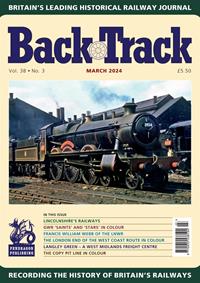|
|
Contents Listing - Articles & Features in this issue
Dark Times at Lime Street
Summer Saturdays to the Coast - Part One
A Derailment without apparent cause
Making Tracks: British Transport Firns and the History of British Railways 1950-1983
Tragedy, Trespass and Trivia on the Tanfield Branch, North Eastern Railway
Going Round the ’Halls’
Hellifield - Rural Backwater to Major Railway Junction
'Go West - Life is peaceful there'
Strabane-A Lost Railway Centre killed by Partition and Religion - Part Two
Postcards from Towd Ratty
The Mail - Second Delivery
Gone to Gloucester
Frustrations of Fuel Efficiency - Part One
LNER Phoenix
Readers' Forum
Book Reviews
Cover - GWR 'Hall'4-6-0 No.4989 Cherwell Hall approaches Lapworth heading south on the Birmingham main line in 1962. (Derek Penney)
Article Snippets
RECORDING THE HISTORY OF BRITAIN'S RAILWAYS:
Lights - Camera - Action Going to the cinema to watch a film isn't something we've been doing much in recent times; in fact, as I write this (in May) my last evening out was to go to the film night in the local community centre in February last year. In any case, going out 'to the pictures' hasn't been the occasion it used to be for quite some time. There isn't much of a classy experience, in my considered opinion, in attending a screening in one of the in-vogue multiplex cinematic emporia where you are force-fed a long series of trailers for movies you probably aren't the least inclined to watch, followed by Pearl & Dean commercials for products you aren't the least inclined to afford, before eventually having your eardrums blasted by your chosen film delivered at reverberating volume. Remember when a night at the cinema involved being treated to a full programme? As well as the 'main feature' you'd have a shorter 'B' picture, invariably in black and white, often not a bad story, sometimes with then little-known actors who would go on to greater renown. Between them and the adverts, you could very well also be given a news documentary. During the war these could be bulletins from hot spots in the conflict: raids over enemy territory, troop landings, stoical citizens in 'Britain can take it' mode. Later, into the 1960s when television news coverage was still scanter and sparser than we're accustomed to nowadays, we'd see reports of events such as general elections, Her Majesty's visits to Commonwealth countries, major sporting fixtures and 'Look at Life' delights such as sheep judging at country shows, village cricket matches or bell-ringing competitions.
Into the world of industrial film production stepped British Transport Films, established in 1949 by the new nationalised British Transport Commission and headed by Edgar Anstey who later declared "To celebrate the railwayman's contribution to national life has been one of the objects of our film making." What we know BTF for are those productions made for public showing to present information about the operation of the national transport system and to promote travel on it - what we came to call 'travelogues'. A further and certainly no less important activity was the compiling of instructional films for staff, explaining the modernisation of the railway that was unfolding and the new practices it brought. The films were shown in cinemas and later increasingly on television, at travel fairs, in stations and even on board British Railways ships; many will recall viewing a BT Film as a supporting feature of their night out 'at the pictures'. The films could also be hired by all manner of non-theatrical bodies: trade, professional and educational groups along with a variety of clubs and societies. From these wide-ranging productions we are able to look back over our changing travel patterns - in terms of technology, passenger experience, the journeys we make, the places we visit and the holidays we take. In my previous employment an occasional duty was to project some of the choicest BT Films to public audiences. In deciding on the film I was focussed on what would entertain the 'average punter' for half an hour or so, taking into account that some would be railway enthusiasts and others would just be drawn in out of curiosity. The 'technical'films would be ruled out and probably those publicising holiday destinations, so I would opt for ones demonstrating the railway of the past at work with plenty of trains and 'things happening'. Going by audience reaction, on no scientific basis whatsoever, two of the best-received were Elizabethan Express, the 1954 journey on the London-Edinburgh 'non-stop', and Terminus which charted a day in the life of London's Waterloo station in 1961. Both have become regarded as classics of their genre.
Elizabethan Express follows the train throughout from the signing-on of the driverand fireman at King's Cross depot to its greeting by the station master at Edinburgh Waverley, with an abundance of lineside, footplate and in-train sequences. Most of the landmark moments are covered, such as the crew change halfway by means of the corridor tender, scooping water on the troughs and crossing the border, while inside the carriages midday dinner is cooked and served, passengers read, doze... and dine. An oddity is the commentary which is delivered entirely in rhyming verse, some of the lines being quite stirring, others making you wince a bit. They are spoken by the actors Alan Wheatley, who might be called to mind playing the silkily villainous Sheriff of Nottingham in the 'Robin Hood' TV series of the late 1950s, and Howard Marion-Crawford who was a pal of my father in the RAF during the last unpleasantness! Terminus was an early credit for the director John Schlesinger who went on to become a big name in Hollywood. It is an observational documentary of the comings and goings at Waterloo station from the frenzy of commuter peaks to the lonelier hours of the night, following the activities of staff and passengers and recording forms of railway traffic now vanished: the arrival of liner trains from Southampton, the conveyance of convicts, the loading of coffins. The most memorable scene involves the little boy who for dramatic effect was deliberately 'lost' briefly by his mother (a relative of Schlesinger) but swiftly rescued by a policeman. I rather doubt if a stunt like that would be pulled today!
Other popular films were Farmer moving South (self-explanatory), Train Time (grappling with such as the seasonal broccoli harvest in Cornwall, tinplate output in South Wales and cattle imports from Ireland), Fully Fitted Freight (tracking the Bristol-Leeds express goods), This is York (following the station master on his rounds) and the great Snowdrift at Bleath Gill (the rescuing of a frozen engine and wagons in the high Pennines on the Stainmore route). In some productions real railwaymen and locals made cameo appearances with a few words to speak, which they tended to do as if from the school of wooden acting, but that only seems to add to their idiosyncratic charm. These well crafted films, and many others in the archive, could be considered 'of their time' in the style of their presentation, but when made they were a showcase for the railway at that time and today they reflect how much it has changed. We can be glad of the insight into a different world which the silver screen affords us and an article this month tells us more about the world of British Transport Films.
Lights - Camera - Action Going to the cinema to watch a film isn't something we've been doing much in recent times; in fact, as I write this (in May) my last evening out was to go to the film night in the local community centre in February last year. In any case, going out 'to the pictures' hasn't been the occasion it used to be for quite some time. There isn't much of a classy experience, in my considered opinion, in attending a screening in one of the in-vogue multiplex cinematic emporia where you are force-fed a long series of trailers for movies you probably aren't the least inclined to watch, followed by Pearl & Dean commercials for products you aren't the least inclined to afford, before eventually having your eardrums blasted by your chosen film delivered at reverberating volume. Remember when a night at the cinema involved being treated to a full programme? As well as the 'main feature' you'd have a shorter 'B' picture, invariably in black and white, often not a bad story, sometimes with then little-known actors who would go on to greater renown. Between them and the adverts, you could very well also be given a news documentary. During the war these could be bulletins from hot spots in the conflict: raids over enemy territory, troop landings, stoical citizens in 'Britain can take it' mode. Later, into the 1960s when television news coverage was still scanter and sparser than we're accustomed to nowadays, we'd see reports of events such as general elections, Her Majesty's visits to Commonwealth countries, major sporting fixtures and 'Look at Life' delights such as sheep judging at country shows, village cricket matches or bell-ringing competitions.
Into the world of industrial film production stepped British Transport Films, established in 1949 by the new nationalised British Transport Commission and headed by Edgar Anstey who later declared "To celebrate the railwayman's contribution to national life has been one of the objects of our film making." What we know BTF for are those productions made for public showing to present information about the operation of the national transport system and to promote travel on it - what we came to call 'travelogues'. A further and certainly no less important activity was the compiling of instructional films for staff, explaining the modernisation of the railway that was unfolding and the new practices it brought. The films were shown in cinemas and later increasingly on television, at travel fairs, in stations and even on board British Railways ships; many will recall viewing a BT Film as a supporting feature of their night out 'at the pictures'. The films could also be hired by all manner of non-theatrical bodies: trade, professional and educational groups along with a variety of clubs and societies. From these wide-ranging productions we are able to look back over our changing travel patterns - in terms of technology, passenger experience, the journeys we make, the places we visit and the holidays we take. In my previous employment an occasional duty was to project some of the choicest BT Films to public audiences. In deciding on the film I was focussed on what would entertain the 'average punter' for half an hour or so, taking into account that some would be railway enthusiasts and others would just be drawn in out of curiosity. The 'technical'films would be ruled out and probably those publicising holiday destinations, so I would opt for ones demonstrating the railway of the past at work with plenty of trains and 'things happening'. Going by audience reaction, on no scientific basis whatsoever, two of the best-received were Elizabethan Express, the 1954 journey on the London-Edinburgh 'non-stop', and Terminus which charted a day in the life of London's Waterloo station in 1961. Both have become regarded as classics of their genre.
Elizabethan Express follows the train throughout from the signing-on of the driverand fireman at King's Cross depot to its greeting by the station master at Edinburgh Waverley, with an abundance of lineside, footplate and in-train sequences. Most of the landmark moments are covered, such as the crew change halfway by means of the corridor tender, scooping water on the troughs and crossing the border, while inside the carriages midday dinner is cooked and served, passengers read, doze... and dine. An oddity is the commentary which is delivered entirely in rhyming verse, some of the lines being quite stirring, others making you wince a bit. They are spoken by the actors Alan Wheatley, who might be called to mind playing the silkily villainous Sheriff of Nottingham in the 'Robin Hood' TV series of the late 1950s, and Howard Marion-Crawford who was a pal of my father in the RAF during the last unpleasantness! Terminus was an early credit for the director John Schlesinger who went on to become a big name in Hollywood. It is an observational documentary of the comings and goings at Waterloo station from the frenzy of commuter peaks to the lonelier hours of the night, following the activities of staff and passengers and recording forms of railway traffic now vanished: the arrival of liner trains from Southampton, the conveyance of convicts, the loading of coffins. The most memorable scene involves the little boy who for dramatic effect was deliberately 'lost' briefly by his mother (a relative of Schlesinger) but swiftly rescued by a policeman. I rather doubt if a stunt like that would be pulled today!
Other popular films were Farmer moving South (self-explanatory), Train Time (grappling with such as the seasonal broccoli harvest in Cornwall, tinplate output in South Wales and cattle imports from Ireland), Fully Fitted Freight (tracking the Bristol-Leeds express goods), This is York (following the station master on his rounds) and the great Snowdrift at Bleath Gill (the rescuing of a frozen engine and wagons in the high Pennines on the Stainmore route). In some productions real railwaymen and locals made cameo appearances with a few words to speak, which they tended to do as if from the school of wooden acting, but that only seems to add to their idiosyncratic charm. These well crafted films, and many others in the archive, could be considered 'of their time' in the style of their presentation, but when made they were a showcase for the railway at that time and today they reflect how much it has changed. We can be glad of the insight into a different world which the silver screen affords us and an article this month tells us more about the world of British Transport Films.
Adverts and Links based on this content
Advertisement




